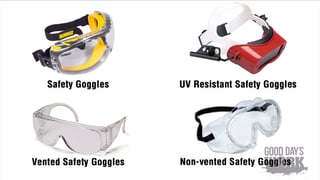Personal protective equipment (PPE) is an important part of running a successful agricultural operation. We’ve talked about PPE in the past, but now we’re going to take a closer look at equipment to keep your eyes and face from injury.
 Safety Glasses
Safety Glasses
Safety glasses are intended for use against impact injuries from flying objects, such as flying fragments, chips, and other particles. When choosing your safety glasses, there are some considerations to keep in mind:
- Lenses may be flat or curved; clear, filtered, or tinted; and may include removable lenses.
- The frames may have spatula temples (which fit over the ear), cable temples (fit around the ear), headband temples, and bridges. All of these can be adjustable.
- Side shields provide angular protection from flying objects. Side shields can be permanent or removable, solid or ventilated, and tinted or clear.
Safety Goggles
Safety goggles provide protection in addition to that provided by safety glasses. They are designed to be form-fitting and provide a protective seal. This is particularly useful when working with dangerous chemicals. In addition to the protections listed above, safety goggles may also provide ventilation (direct or indirect) to prevent the lenses from fogging.
Face Shield
Face shields protect the entire face, not just the eyes. They should, however, always be used with safety glasses or goggles as they do not provide adequate protection by themselves. There are two parts to a face shield:
- The window is a removable piece, allowing for replacement when damaged. It protects against light-to-moderate impact and may be clear or filtered. Wire-screened windows should not be used when working with chemicals.
- The headgear includes a strap that allows the user to adjust the shield to a proper fit. Some include a hardhat for additional protection.



